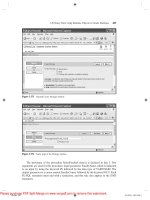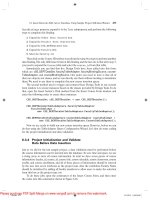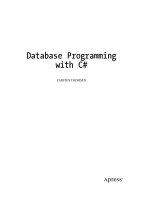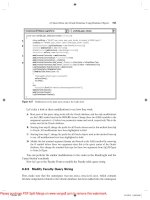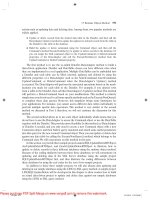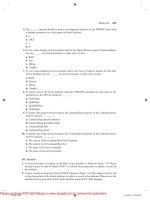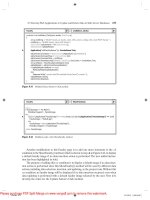Mastering C Sharp Database Programming doc
Bạn đang xem bản rút gọn của tài liệu. Xem và tải ngay bản đầy đủ của tài liệu tại đây (10.48 MB, 385 trang )
© 2004 Your company
Standard print
manual template
Title page 1
Use this page to introduce the product
by <AUTHOR>
This is "Title Page 1" - you may use this page to introduce
your product, show title, author, copyright, company logos,
etc.
This page intentionally starts on an odd page, so that it is on
the right half of an open book from the readers point of
view. This is the reason why the previous page was blank
(the previous page is the back side of the cover)
All rights reserved. No parts of this work may be reproduced in any form or by any means - graphic, electronic, or
mechanical, including photocopying, recording, taping, or information storage and retrieval systems - without the
written permission of the publisher.
Products that are referred to in this document may be either trademarks and/or registered trademarks of the
respective owners. The publisher and the author make no claim to these trademarks.
While every precaution has been taken in the preparation of this document, the publisher and the author assume no
responsibility for errors or omissions, or for damages resulting from the use of information contained in this document
or from the use of programs and source code that may accompany it. In no event shall the publisher and the author be
liable for any loss of profit or any other commercial damage caused or alleged to have been caused directly or
indirectly by this document.
Printed: September 2004 in (whereever you are located)
Mastering C# Database Programming
@Team LiB
© 2004 Your company
Publisher
Special thanks to:
All the people who contributed to this document, to mum and dad
and grandpa, to my sisters and brothers and mothers in law, to our
secretary Kathrin, to the graphic artist who created this great
product logo on the cover page (sorry, don't remember your name
at the moment but you did a great work), to the pizza service down
the street (your daily Capricciosas saved our lives), to the copy
shop where this document will be duplicated, and and and
Last not least, we want to thank EC Software who wrote this great
help tool called HELP & MANUAL which printed this document.
Managing Editor
Technical Editors
Cover Designer
enter name
enter name
enter name
enter name
enter name
Production
enter name
Team Coordinator
enter name
Table of Contents
Foreword
1
Part I
Table of Contents
3
Part II
BackCover
5
Part III
Mastering C# Database Programming
7
Part IV
Introduction
9
91 How to Use This Book
112 Downloading the Example Programs
Part V
Part 1: Introduction to ADO.NET and
Databases
13
131 Chapter 1: Introduction to Database Programming with ADO.NET
13Obtaining the Required Software
14Developing Your First ADO.NET Program
17Connecting to Access and Oracle Databases
19Introducing Visual Studio .NET
23Using the .NET Documentation
25Using the SQL Server Documentation
26Summary
262 Chapter 2: Introduction to Databases
27Introducing Databases
28Using SQL Server
34Exploring the Northwind Database
43Building Queries Using Enterprise Manager
45Creating a Table
50Summary
513 Chapter 3: Introduction to Structured Query Language (SQL)
51Using SQL
70Accessing a Database Using Visual Studio .NET
73Summary
734 Chapter 4: Introduction to Transact-SQL Programming
74Fundamentals of Transact-SQL
77Using Cursors
78Using Functions
86Creating User-Defined Functions
89Introducing Stored Procedures
91Introducing Triggers
94Summary
945 Chapter 5: Overview of the ADO.NET Classes
95The Managed Provider and Generic Data Set Classes
98Performing a SQL SELECT Statement and Storing the Rows Locally
102Summary
Mastering C# Database Programming @Team LiBI
© 2004 Your company
1026 Chapter 6: Introducing Windows Applications and ADO.NET
103Developing a Simple Windows Application
109Using Windows Controls
110Using a DataGrid Control to Access a Database
116Using the Data Form Wizard to Create a Windows Form
124Summary
Part VI
Part 2: Fundamental Database Programming
with ADO.NET
126
1261 Chapter 7: Connecting to a Database
126Understanding the SqlConnection Class
128Using a SqlConnection Object to Connect to a SQL Server Database
132Creating a Connection Object Using Visual Studio .NET
137Summary
1382 Chapter 8: Executing Database Commands
138The SqlCommand Class
140Creating a SqlCommand Object
141Executing SELECT Statements and TableDirect Commands
149Executing Commands that Modify Information in the Database
151Introducing Transactions
152Supplying Parameters to Commands
156Executing SQL Server Stored Procedures
160Creating a Command Object Using Visual Studio .NET
161Summary
1623 Chapter 9: Using DataReader Objects to Read Results
162The SqlDataReader Class
165Creating a SqlDataReader Object
165Reading Rows from a SqlDataReader Object
167Returning Strongly Typed Column Values
168Using the Get* Methods to Read Column Values
170An Example of Using the Get* Methods
177Reading Null Values
177Executing Multiple SQL Statements
179Using a DataReader Object in Visual Studio .NET
181Summary
1824 Chapter 10: Using Dataset Objects to Store Data
182The SqlDataAdapter Class
185The DataSet Class
195Writing and Reading XML Using a DataSet Object
198Mapping Tables and Columns
199Reading a Column Value Using Strongly Typed DataSet Classes
203Creating a DataAdapter Object Using Visual Studio .NET
207Creating a DataSet Object Using Visual Studio .NET
208Summary
2085 Chapter 11: Using DataSet Objects to Modify Data
209The DataTable Class
211The DataRow Class
212The DataColumn Class
213Adding Restrictions to DataTable and DataColumn Objects
221Finding, Filtering, and Sorting Rows in a DataTable
223Modifying Rows in a DataTable
IIContents
II
© 2004 Your company
228Retrieving New Identity Column Values
230Using Stored Procedures to Add, Modify, and Remove Rows from the Database
235Automatically Generating SQL Statements
236Exploring the DataAdapter and DataTable Events
240Dealing with Update Failures
242Using Transactions with a DataSet (SQL)
243Modifying Data Using a Strongly Typed DataSet
244Summary
2456 Chapter 12: Navigating and Modifying Related Data
245The UniqueConstraint Class
246Creating a UniqueConstraint Object
247The ForeignKeyConstraint Class
248Creating a ForeignKeyConstraint Object
249The DataRelation Class
250Creating and Using a DataRelation Object
252Adding, Updating, and Deleting Related Rows
256Issues Involved When Updating the Primary Key of a Parent Row
259Nested XML
261Defining a Relationship Using Visual Studio .NET
264Summary
2647 Chapter 13: Using DataView Objects
265The DataView Class
267Creating and Using a DataView Object
268Using the Default Sort Algorithm
269Performing Advanced Filtering
269The DataRowView Class
270Finding DataRowView Objects in a DataView
271Adding, Modifying, and Removing DataRowView Objects from a DataView
273Creating Child DataView Objects
274The DataViewManager Class
274Creating and Using a DataViewManager Object
275Creating a DataView Using Visual Studio .NET
277Summary
Part VII
Part 3: Advanced Database Programming with
ADO.NET
279
2791 Chapter 14: Advanced Transaction Control
279The SqlTransaction Class
280Setting a Savepoint
282Setting the Transaction Isolation Level
286Understanding SQL Server Locks
293Summary
2932 Chapter 15: Introducing Web Applications-ASP.NET
294Creating a Simple ASP.NET Web Application Using VS .NET
297The Web Form Controls
299Building a More Complex Application
302Using a DataGrid Control to Access a Database
310Using a DataList Control to Access a Database
315Maintaining State in a Web Application
318Creating a Simple Shopping Cart Application
322Summary
3223 Chapter 16: Using SQL Server's XML Support
Mastering C# Database Programming @Team LiBIII
© 2004 Your company
322Using the SQL Server FOR XML Clause
327Introducing XPath
329Introducing XSLT
331Accessing SQL Server Using HTTP
339Using the SQL Server OPENXML() Function
341Using an XmlDocument Object to Store an XML Document
346Using an XmlDataDocument Object to Store an XML Document
348Summary
3494 Chapter 17: Web Services
349Creating a Web Service
351Viewing a WSDL File and Testing a Web Service
354Using a Web Service
356Registering a Web Service
359Summary
Part VIII
Index
362
3621 Index_B
3622 Index_C
3623 Index_D
3624 Index_E
3625 Index_F
3626 Index_G
3627 Index_H
3628 Index_I
3629 Index_J
36210 Index_K
36211 Index_L
36312 Index_M
36313 Index_N
36314 Index_O
36315 Index_P
36316 Index_Q
36317 Index_R
36318 Index_S
36319 Index_T
36320 Index_U
36321 Index_V
36322 Index_W
36323 Index_X
36324 Index_Y
Part IX
List of Figures
365
IVContents
IV
© 2004 Your company
Part X
List of Tables
369
Part XI
List of Listings
372
Part XII
List of Sidebars
375
Index 0
Mastering C# Database Programming @Team LiBV
© 2004 Your company
Foreword
This is just another title page
placed between table of contents
and topics
1Foreword
© 2004 Your company
Top Level Intro
This page is printed before a
new top-level chapter starts
Part
I
Table of Contents 3
© 2004 Your company
1 Table of Contents
Mastering C# Database Programmingby Jason Price
ISBN:0782141838
Top Level Intro
This page is printed before a
new top-level chapter starts
Part
II
BackCover 5
© 2004 Your company
2 BackCover
Back Cover
C# and ADO.NET facilitate the development of a new generation of database applications, including
remote applications that run on the Web.
Mastering C# Database Programming
is the resource you
need to thrive in this new world. Assuming no prior experience with database programming, this book
teaches you every aspect of the craft, from GUI design to server development to middle-tier
implementation. If youre familiar with earlier versions of ADO, youll master the many new features of
ADO.NET all the more quickly. Youll also learn the importance of XML within the new .NET
paradigm.
Coverage IncludesAccessing a database using C# and ADO.NETUsing SQL to access a
databaseUsing Visual Studio .NET to build applicationsCreating and modifying database
tablesUnderstanding ADO.NET classesDesigning, building, and deploying Web applications that
access a databaseDesigning, building, and deploying effective Web servicesUsing SQL Servers built-
in XML capabilitiesWorking with a database in a disconnected mannerUsing advanced transaction
controlsUsing Transact-SQL to create stored procedures and functions in a SQL Server database
About the Author
Jason Price is an independent consultant and writer, and is both a Microsoft Certified Professional
and an Oracle Certified Professional. Jason has more than 10 years of experience in the software
industry, and he has extensive experience with C#, .NET, and Java. He is the author of
Mastering
Visual C# .NET, Oracle9i JDBC Programming
, and
Java Programming with Oracle SQLJ.
Top Level Intro
This page is printed before a
new top-level chapter starts
Part
III
Mastering C# Database Programming 7
© 2004 Your company
3 Mastering C# Database Programming
Top Level Intro
This page is printed before a
new top-level chapter starts
Part
IV
Introduction 9
© 2004 Your company
4 Introduction
Introduction
Welcome to
Mastering C# .NET Database Programming
! As you might already know, .NET is poised
to become
the
hot platform for the next wave of technology deployment. .NET's strength is that it is
built from the ground up to be used in a distributed environment-in other words, an environment that
consists of computers and devices connected via a network.Note
The focus of this book is how you write C# programs that interact with a database. C# uses ADO.NET
to interact with a database; ADO.NET is the successor to ADO. In this book, you'll learn the details of
interacting with a SQL Server database. SQL Server is Microsoft's premier database software.
Microsoft has pledged its commitment and resources to making .NET a pervasive component of life in
our technological society-ignore .NET at your own peril. The bottom line is you need to learn .NET if
you want to remain competitive in today's-and tomorrow's-marketplace.
In a nutshell, .NET is a completely new framework for writing many types of applications. The
applications you can write using .NET include Windows applications and Web-based applications.
You can use .NET to develop systems composed of interconnected services that communicate with
each other over the Internet.
In addition, you can use .NET to create applications that run on devices such as handheld computers
and cellular phones. Although other languages allow you to develop such applications, .NET was
designed with the interconnected network in mind.
The .NET Framework consists of three primary components:
Development Languages and Tools
The development languages that enable you to write .NET
programs include C#, Visual Basic .NET (VB .NET), and Managed C++. Microsoft also has a Rapid
Application Development (RAD) tool called Visual Studio .NET (VS .NET) that allows you to develop
programs in an integrated development environment (IDE). You'll use C# and VS .NET in this book.
Common Language Runtime (CLR)
CLR manages your running code and provides services such
as memory management, thread management (which allows you to perform multiple tasks in parallel),
and remoting (which allows objects in one application to communicate with objects in another
application). The CLR also enforces strict safety and accuracy of your executable code to ensure that
no tampering occurs.
Framework Base Class Library
The Framework Base Class Library is an extensive collection of
code written by Microsoft that you can use in your own programs. For example, among many
other
functions, the Framework Base Class Library contains code that allows you to develop Windows
applications, access directories and files on disk, interact with databases, and send and receive data
across a network.
Who Should Read This Book?
This book was written for programmers who already know C#. It contains everything you need to
know to master database programming with C#. No prior experience of databases is assumed, but if
you already have some knowledge of database software such as SQL Server or Oracle, you'll be off
to a running start.Note
If you don't know C#, I recommend the book Mastering Visual C# .NET from Sybex (2002).
4.1 How to Use This Book
How to Use This Book
This book is divided into three parts. In
Part 1
, "Introduction to ADO.NET and Databases," you'll learn
everything you need to know about databases. You'll also be introduced to ADO.NET, which enables
your C# programs to interact with a database. In
Part 2
, "Fundamental Database Programming with
ADO.NET," you'll learn the C# programming with ADO.NET from the ground up. In
Part 3
, "Advanced
Database Programming with ADO.NET," you'll go beyond the basics to learn programming techniques
needed by professional database developers.
The following sections describe the chapters in detail.
Part 1: "Introduction to ADO.NET and
Databases"
In
Chapter 1
, "Introduction to Database Programming with ADO.NET," you'll see how to use
Mastering C# Database Programming @Team LiB10
© 2004 Your company
ADO.NET in a C# program to interact with a database. You also learn about Microsoft's RAD tool,
Visual Studio .NET. Finally, you'll see how to use the extensive documentation from Microsoft that
comes with .NET and SQL Server.
In
Chapter 2
, "Introduction to Databases," you'll learn the details of what databases are and how they
are used to store information. You'll see the use of a SQL Server database named Northwind. This
database contains the information for the fictitious Northwind Company, which sells food products.
This database is one of the example databases that is typically installed with SQL Server.
In
Chapter 3
, "Introduction to the Structured Query Language," you'll learn how to use the Structured
Query Language (SQL) to access a database. You'll see how you use SQL to interact with the
Northwind database, and how to retrieve and modify information stored in that database.
In
Chapter 4
, "Introduction to Transact-SQL Programming," you'll be introduced to programming with
Microsoft's Transact-SQL. Transact-SQL enables you to write programs that contain SQL statements,
along with standard programming constructs such as variables, conditional logic, loops, procedures,
and functions.
In
Chapter 5
, "Overview of the ADO.NET Classes," you'll get an overview of the ADO.NET classes.
You'll also see a C# program that connects to a database, stores the rows locally, disconnects
from
the database, and then reads the contents of those local rows while disconnected from the database.
This ability to store a local copy of rows retrieved from the database is one of the main strengths of
ADO.NET.
In
Chapter 6
, "Introducing Windows Applications and ADO.NET," you'll be introduced to Windows
applications. A Windows application takes advantage of displaying and using the mouse and
keyboard for input. Windows provides graphical items such as menus, text boxes, and radio buttons
so you can build a visual interface that will be easy to use. You'll see how to build Windows
applications that interact with the Northwind database.
Part 2: "Fundamental Database Programming
with ADO.NET"
In
Chapter 7
, "Connecting to a Database," you'll learn the details on connecting to a database. There
are three Connection classes: SqlConnection, OleDbConnection, and OdbcConnection. You use an
object of the SqlConnection class to connect to a SQL Server database. You use an object of the
OleDbConnection class to connect to any database that supports OLE DB (Object Linking and
Embedding for Databases), such as Oracle or Access. You use an object of the OdbcConnection
class to connect to any database that supports ODBC (Open Database Connectivity). Ultimately, all
communication with a database is done through a Connection object.
In
Chapter 8
, "Executing Database Commands," you'll learn the details on executing database
commands. You use a Command object to execute a SQL SELECT, INSERT, UPDATE, or DELETE
statement. You can also use a Command object to call a stored procedure, or retrieve all the rows
and columns from a specific table.
In
Chapter 9
, "Using DataReader Objects to Read Results," you'll see how to use a DataReader
object to read results returned from the database. You use a DataReader object to read rows
retrieved from the database using a Command object.
In
Chapter 10
, "Using DataSet Objects to Store Data," you'll learn how to use a DataSet object to
store results returned from the database. DataSet objects allow you to store a copy of the tables and
rows from the database, and you can work with that local copy while disconnected from the database.
In
Chapter 11
, "Using DataSet Objects to Modify Data," you'll examine how to modify the rows in a
DataSet and then push those changes to the database via a DataAdapter.
In
Chapter 12
, "Navigating and Modifying Related Data," you'll delve into the details of how you
navigate related data in tables, make changes in that data in memory, and finally push those changes
to the database.
In
Chapter 13
, "Using DataView Objects," you'll see how to use DataView objects to filter and sort
rows. The advantage of a DataView is that you can bind it to a visual component in a Windows or
ASP.NET application.
Part 3: "Advanced Database Programming with ADO.NET"
In
Chapter 14
, "Advanced Transaction Control," you'll delve into advanced transaction control using
SQL Server and ADO.NET.
In
Chapter 15
, "Introducing Web Applications: ASP.NET," you'll learn the basics of ASP.NET, and
you'll see how to use Visual Studio .NET to create ASP.NET applications.
In
Chapter 16
, "Using SQL Server's XML Support," you'll learn about SQL Server's extensive support
for XML. You'll also see how to store XML in a C# program using XmlDocument and
Introduction 11
© 2004 Your company
XmlDataDocument objects.
In
Chapter 17
, "Web Services," you'll learn how to build a simple web service, which is a software
component that may be used across the Web. For example, you could build a eb service that allows
one company to send another company an order across the Web using XML.
4.2 Downloading the Example Programs
Downloading the Example Programs
Throughout this book, you'll see many example programs that illustrate the concepts described in the
text. These are marked with a listing number and title, such as the one shown here:
LISTING 1.1
: FIRSTEXAMPLE.CS
The filenames will correspond to the listing name: FirstExample.cs is the filename for
Listing 1.1
. You
can download a Zip file containing the programs from the Sybex Web site at www.sybex.com. You
can use a program such as WinZip to extract the contents of the Zip file.
When you unzip this file, one directory for each chapter will be created. Each directory will contain the
following sub-directories as required:
programs
Contains the C# programs.
sql
Contains SQL scripts.
VS. NET projects
Contains the Visual Studio .NET projects.
xml
Contains the XML files.Note
Not all chapters reference programs, sql scripts, etc., and therefore may not contain all the previous
sub-directories.
Top Level Intro
This page is printed before a
new top-level chapter starts
Part
V
Part 1: Introduction to ADO.NET and Databases 13
© 2004 Your company
5 Part 1: Introduction to ADO.NET and Databases
Part 1: Introduction to ADO.NET and DatabasesChapter List
Chapter 1:
Introduction to Database Programming with ADO.NET
Chapter 2:
Introduction to Databases
Chapter 3:
Introduction to Structured Query Language (SQL)
Chapter 4:
Introduction to Transact-SQL
Programming
Chapter 5:
Overview of the ADO.NET Classes
Chapter 6:
Introducing Windows
Applications and ADO.NET
5.1 Chapter 1: Introduction to Database Programming with ADO.NET
Chapter 1: Introduction to Database Programming with
ADO.NET
Overview
A
Database
is an organized collection of information that is divided into
tables
. Each table is further
divided into
rows
and
columns;
these columns store the actual information. You access a database
using
Structured Query Language
(SQL), which is a standard language supported by most database
software including SQL Server, Access, and Oracle.
In this chapter, you'll see a C# program that connects to a SQL Server database, retrieves and
displays the contents stored in the columns of a row from a table, and then disconnects from the
database. You'll also see programs that connect to Access and Oracle databases.
You'll also learn about Microsoft's rapid application development (RAD) tool, Visual Studio .NET (VS
.NET). VS .NET enables you to develop, run, and debug programs in an integrated development
environment. This environment uses all the great features of Windows, such as the mouse and
intuitive menus, and increases your productivity as a programmer.
In the final sections of this chapter, you'll see how to use the extensive Microsoft documentation that
comes with the .NET Software Development Kit (SDK) and VS .NET. You'll find this documentation
invaluable as you become an expert with ADO.NET and C#. You'll also learn how to use the SQL
Server documentation.
Featured in this chapter:
Obtaining the required software
Developing your first ADO.NET program
Connecting to Access and Oracle databases
Introducing Visual Studio .NET
Using the .NET documentation
Using the SQL Server documentation
5.1.1 Obtaining the Required Software
Obtaining the Required Software
Before you can develop C# programs, you'll need to install either the .NET Software Development Kit
(SDK) or VS .NET. You can download the .NET SDK at (search
for the Microsoft .NET Framework Software Development Kit). You can purchase a trial or full copy of
VS .NET from Microsoft at />To install the .NET SDK, run the executable file you downloaded and follow the instructions on the
screen to install it on your computer. To install VS .NET, run the setup.exe file on the disk and follow
the instructions on the screen.
You'll also need a copy of the SQL Server database software. At time of writing, you can download a
trial version of SQL Server from Microsoft at You can also purchase a
trial or full copy of SQL Server from Microsoft's Web site.
This book uses the Developer Edition of the SQL Server 2000 software and uses a database named
Northwind. This database contains the information for the fictitious Northwind Company, which sells
food products to customers. Northwind is one of the example databases that you can install with SQL
Server. Customer information in the Northwind database is stored in a table named Customers; you'll
Mastering C# Database Programming @Team LiB14
© 2004 Your company
see the use of this table in the example program later in this chapter.
If you don't want to download or purchase a trial version of SQL Server, the .NET SDK (and VS .NET)
comes with a stand-alone desktop database server known as the Microsoft SQL Server 2000 Desktop
Engine (MSDE 2000). MSDE 2000 has a version of the Northwind database that you can use instead
of the SQL Server Northwind database-although you won't get all of the graphical administration tools
that come with SQL Server. If you're using the .NET SDK and want to install MSDE 2000, select Start
£ Microsoft .NET Framework SDK £ Samples and QuickStart Tutorials. If you're using VS .NET and
want to install MSDE 2000, run the setup.exe program that you use to install VS .NET and select
MSDE 2000 as a new feature to install.Note
You can learn more about MSDE 2000 at
/> .
5.1.2 Developing Your First ADO.NET Program
Developing Your First ADO.NET Program
In this section you'll plunge into ADO.NET programming and see a C# program that performs the
following tasks:
Connects to the SQL Server Northwind database
Retrieves a row from the Customers table
Displays the columns from the row
Closes the database connection
You'll be introduced to many concepts in this section that are fully explored in later chapters. Don't be
too concerned about all the details of the concepts at this stage; you'll learn those details in the later
chapters.
Listing 1.1 shows the example program, which is contained in the file FirstExample.cs.Listing 1.1:
FIRSTEXAMPLE.CS
/* FirstExample.cs illustrates how to: 1. Connect to the SQL Server
Northwind database. 2. Retrieve a row from the Customers table using a SQL SELECT
statement. 3. Display the columns from the row. 4. Close the database connection. */ using
System; using System.Data.SqlClient; class FirstExample { public static void Main() { try {
// step 1: create a SqlConnection object to connect to the // SQL Server Northwind database
SqlConnection mySqlConnection = new SqlConnection(
"server=localhost;database=Northwind;uid=sa;pwd=sa" ); // step 2: create a SqlCommand
object SqlCommand mySqlCommand = mySqlConnection.CreateCommand(); // step 3: set
the CommandText property of the SqlCommand object to // a SQL SELECT statement that
retrieves a row from the Customers table mySqlCommand.CommandText = "SELECT
CustomerID, CompanyName, ContactName, Address "+ "FROM Customers "+ "WHERE
CustomerID = 'ALFKI'"; // step 4: open the database connection using the // Open() method of
the SqlConnection object mySqlConnection.Open();
// step 5: create a SqlDataReader object
and call the ExecuteReader() // method of the SqlCommand object to run the SELECT statement
SqlDataReader mySqlDataReader = mySqlCommand.ExecuteReader(); // step 6: read the row
from the SqlDataReader object using // the Read() method mySqlDataReader.Read(); //
step 7: display the column values Console.WriteLine("mySqlDataReader[\" CustomerID\"] = "+
mySqlDataReader["CustomerID"]); Console.WriteLine("mySqlDataReader[\" CompanyName\"] =
"+ mySqlDataReader["CompanyName"]); Console.WriteLine("mySqlDataReader[\"
ContactName\"] = "+ mySqlDataReader["ContactName"]);
Console.WriteLine("mySqlDataReader[\" Address\"] = "+ mySqlDataReader["Address"]); //
step 8: close the SqlDataReader object using the Close() method mySqlDataReader.Close();
// step 9: close the SqlConnection object using the Close() method mySqlConnection.Close(); }
catch (SqlException e) { Console.WriteLine("A SqlException was thrown");
Console.WriteLine("Number = "+ e.Number); Console.WriteLine("Message = "+ e.Message);
Console.WriteLine("StackTrace:\n" + e.StackTrace); } } }
Note
You can download all the source files for the programs featured in this book from the Sybex Web site
at
www.sybex.com
. You'll find instructions on downloading these files in the introduction of this book.
Once you've downloaded the files, you can follow along with the examples without having to type in
the program listings.
Part 1: Introduction to ADO.NET and Databases 15
© 2004 Your company
Let's go through the lines in FirstExample.cs. The first set of lines is a comment that indicates what
the program does: /* FirstExample.cs illustrates how to: 1. Connect to the SQL Server Northwind
database. 2. Retrieve a row from the Customers table using a SQL SELECT statement. 3.
Display the columns from the row. 4. Close the database connection. */
The next two lines indicate the namespaces being referenced in the program with the using
statement: using System; using System.Data.SqlClient;
The System namespace is the root namespace and is referenced so that we can simply use
Console.WriteLine() calls in the program, rather than the fully qualified System.Console.WriteLine()
call. The System.Data.SqlClient namespace contains the ADO.NET classes for use with SQL Server,
including the SqlConnection, SqlCommand, and SqlDataReader classes that are used later in the
program. You'll be introduced to these classes shortly, and you'll learn the full details of the ADO.NET
classes as you progress through this book.
You handle exceptions that might be thrown in your code by placing the code within a try/catch block.
You'll notice that the nine steps are placed within a try/catch block in the Main() method, with the
catch block handling a SqlException object that might be thrown by the code in the try block. You'll
learn more about this later in the section "Handling Exceptions" after I've discussed the nine steps in
the following sections.
Step 1: Create a
SqlConnection
Object to Connect to the Database
You use an object of the SqlConnection class to connect to a SQL Server database. Step 1 in the
Main() method creates a SqlConnection object named mySqlConnection to connect to the SQL Server
Northwind database: SqlConnection mySqlConnection = new SqlConnection(
"server=localhost;database=Northwind;uid=sa;pwd=sa" );
The string passed to the SqlConnection constructor is known as the
connection string
and contains
the following elements:
server
Specifies the name of the computer on which SQL Server is running-localhost in this example;
localhost is a common name that refers to the computer on which your program runs. If your database
is running on a computer other than the one your program is running on, then you'll need to replace
localhost with the name of that computer.
database
Specifies the name of the database-Northwind in this example.
uid
Specifies the name of the database user account-sa in this example; sa is a common database
user account used by the database administrator (DBA). You can use any database user account as
long as it has access to the Northwind database.
pwd
Specifies the password for the user. The password for the sa user in my database is also sa.
You'll need to change pwd to the password for your sa account, or whichever account you specified in
uid.
You'll need to change the settings of some or all of the previous elements in your connection string.
You might need to speak with your DBA to get the various elements that make up your connection
string. Once you have the correct values, you should make the changes to the connection string in
your copy of FirstExample.cs.Note
A database administrator (DBA) is responsible for performing tasks such as installing the database
software, backing up the databases, and so on.
Step 2: Create a
SqlCommand
Object
Step 2 creates a SqlCommand object named mySqlCommand that is used later to send a SELECT
statement to the database for execution. SqlCommand mySqlCommand =
mySqlConnection.CreateCommand();
Step 3: Set the
CommandText
Property of the
SqlCommand
Object
You use SQL to work with the information stored in a database. SQL is an industry standard language
supported by SQL Server, Access, and Oracle. You use the SQL SELECT statement for retrieving
information from a database. You'll learn the basics of SQL in
Chapter 3
, "Introduction to the
Structured Query Language."
Step 3 sets the CommandText property of mySqlCommand created in the previous step to a SELECT
statement. This statement will retrieve the CustomerID, CompanyName, ContactName, and Address
columns from the row in the Customers table whose CustomerID is ALFKI:
mySqlCommand.CommandText = "SELECT CustomerID, CompanyName, ContactName, Address "+
"FROM Customers "+ "WHERE CustomerID = 'ALFKI'";
Step 4: Open the
SqlConnection
Object
Step 4 opens the database connection using the Open() method of the SqlConnection object created
in step 1: mySqlConnection.Open();
Once the connection to the database is open, you can send commands to the database for
Mastering C# Database Programming @Team LiB16
© 2004 Your company
execution.
Step 5: Run the
SELECT
Statement
You run the SELECT statement previously set in mySqlCommand by calling the ExecuteReader()
method. This method returns a SqlDataReader object that you then use to read the row data returned
by the SELECT statement.
Step 5 creates a SqlDataReader object and calls the ExecuteReader() method of mySqlCommand
object to run the SELECT statement: SqlDataReader mySqlDataReader =
mySqlCommand.ExecuteReader();
Step 6: Read the Row Using the
SqlDataReader
Object
Step 6 reads the row in mySqlDataReader using the Read() method: mySqlDataReader.Read();
Step
7: Display the Column Values from the
SqlDataReader
Object
You can read the value for a column from mySqlDataReader by passing the name of the column in
square brackets. For example, mySqlDataReader["CustomerID"] returns the value of the CustomerID
column.
Step 7 displays the column values for the CustomerID, CompanyName, ContactName, and Address
column values: Console.WriteLine("mySqlDataReader[\" CustomerID\"] = "+
mySqlDataReader["CustomerID"]); Console.WriteLine("mySqlDataReader[\" CompanyName\"] = "+
mySqlDataReader["CompanyName"]); Console.WriteLine("mySqlDataReader[\" ContactName\"] = "+
mySqlDataReader["ContactName"]); Console.WriteLine("mySqlDataReader[\" Address\"] = "+
mySqlDataReader["Address"]);
Step 8: Close the
SqlDataReader
Object
When you're finished reading rows from a SqlDataReader object, close it using the Close() method.
Step 8 calls the Close() method for mySqlDataReader: mySqlDataReader.Close();
Step 9: Close the
SqlConnection
Object
When you're finished accessing the database, close your SqlConnection object using the Close()
method. Step 9 calls the Close() method for mySqlConnection: mySqlConnection.Close();
Handling
Exceptions
You handle exceptions that might be thrown in your code by placing the code within a try/catch block.
You'll notice that the nine steps are placed within a try/catch block, with the catch block handling a
SqlException object that might be thrown by the code in the try block. The SqlException class is
specifically for use with code that accesses a SQL Server database.
The following example shows how to structure a try/catch block: try { /* code that might throw a
SqlException */ } catch (SqlException e) {
Console.WriteLine("A SqlException was thrown");
Console.WriteLine("Number = "+ e.Number); Console.WriteLine("Message = "+ e.Message);
Console.WriteLine("StackTrace:\n" + e.StackTrace); }
The properties displayed in the catch block are as follows:
Number
The error number
Message
A string containing a description of the error
StackTrace
A string containing the name of the class and the method from which the exception was
thrown
The two most common examples of when a SqlException object is thrown are as follows:
Your SqlConnection object is unable to connect to the database. If this happens, you should check
the connection string that specifies how to connect to your database.
Your SELECT statement contains a mistake in the spelling of a table or column.
The following example output shows what happens when the SqlConnection object in FirstExample.cs
is unable to connect to the database because the database is currently down: A SqlException was
thrown Number = -2 Message = Timeout expired. Possible reasons: the timeout period elapsed prior
to completion of the operation, the server is not responding, or the maximum pool size was
exceeded. Please see the documentation for further details. StackTrace: at
System.Data.SqlClient.SqlConnection.Open() at FirstExample.Main()
You can use the output from your catch block to determine the problem. If the database is down,
contact your DBA.Note
For brevity, the only program to use a
try
/
catch
block in this book is
FirstExample.cs
. You should
use
try
/
catch
blocks in your own programs to catch exceptions. For more details on handling
exceptions, I recommend the book Mastering Visual C# .NET from Sybex (2002).
In the next section you'll see how to compile FirstExample.cs and run it.
Compiling and Running
FirstExample.cs
You can compile the FirstExample.cs program using either the command-line tool that comes with the
.NET SDK or VS .NET. In this section, you'll see how to use the command-line version of the compiler
Part 1: Introduction to ADO.NET and Databases 17
© 2004 Your company
for FirstExample.cs program. Later in this chapter, in the section "
Introducing Visual Studio .NET
,"
you'll see how to use VS .NET to compile and run a program.
You run the command-line version of the compiler by entering csc in the Command Prompt tool,
followed by the name of your program source file. For example, to compile FirstExample.cs, you
would enter the following command in the Command Prompt tool: csc FirstExample.cs
If you want to follow along with the examples, start the Command Prompt tool by selecting Start £
Programs £ Accessories £ Command Prompt.Note
If you're using Windows XP rather than Windows 2000, start the Command Prompt tool by selecting
Start £ All Programs £ Accessories £ Command Prompt.
Next, you need to change directories to where you copied the FirstExample.cs file. To do this, you
first enter the partition on your hard disk where you saved the file. For example, let's say you saved
the file in the ADO.NET\book\ch01\programs directory of the C partition of your hard disk. To access
the C partition, you enter the following line into the Command Prompt tool and then you press the
Enter key: C:
Next, to move to the ADO.NET\book\ch01\programs directory, you enter cd followed by
ADO.NET\book\ch01\programs: cd ADO.NET\book\ch01\programs
To compile FirstExample.cs using csc, you enter the following command: csc FirstExample.cs
Notice that the name of the program source file follows csc; in this case, it's FirstExample.cs.
If you get an error when running csc, you'll need to add the directory where you installed the SDK to
your Path environment variable. The Path environment variable specifies a list of directories that
contain executable programs. Whenever you run a program from the command prompt, the
directories in the Path variable are searched for the program you want to run. Your current directory is
also searched. To set your Path environment variable, do the following:
Select Start £ Settings £ Control Panel. Then double-click System and select the Advanced tab.
Click the Environment Variables button and double-click Path from the system variables area at the
bottom.
Add the directory where you installed the SDK to your Path environment variable.
Click OK to save your change, and then click OK again on the next dialog.
Restart Command Prompt so that your change is picked up. You should then be able to run csc
successfully.
The compiler takes the FirstExample.cs file and compiles it into an executable file named
FirstExample.exe. The .exe file contains instructions that a computer can run, and the .exe file
extension indicates the file is an executable file.
You run an executable file using the Command Prompt tool by entering the name of that executable
file. For example, to run the FirstExample.exe file, you enter the following line in the Command
Prompt tool and then you press the Enter key: FirstExample
When you run the program, you should see the following text displayed in your Command Prompt
window: mySqlDataReader["CustomerID"] = ALFKI mySqlDataReader["CompanyName"] = Alfreds
Futterkiste mySqlDataReader["ContactName"] = Maria Anders mySqlDataReader["Address"] = Obere
Str. 57
If you encounter an exception-such as your program can't connect to the database-you should check
the connection string set in step 1 of FirstExample.cs, and speak with your DBA if necessary.
5.1.3 Connecting to Access and Oracle Databases
Connecting to Access and Oracle Databases
In this section you'll see examples of connecting to both an Access and an Oracle database. To
interact with either of these databases in your program, you use classes from the System.Data.OleDb
namespace. This namespace contains classes for use with databases that support object linking and
embedding for databases (OLE DB) such as Access or Oracle. You'll learn more about the
System.Data.OleDb namespace in
Chapter 5
, "Overview of the ADO.NET Classes."
Connecting to an
Access Database
You connect to an Access database using an OleDbConnection object-rather than a SqlConnection
object-with a connection string of the following format: provider=Microsoft.Jet.OLEDB.4.0;data
source=
databaseFile



